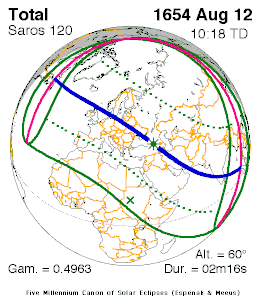Solar eclipse of August 12, 1654
| Solar eclipse of August 12, 1654 | |
|---|---|

|
|
| classification | |
| Type | Total |
| area |
Europe , Middle East , India Total: Newfoundland , Scotland , Denmark , Ukraine , Caucasus , Iran , India |
| Saros cycle | 120 (41 of 71) |
| Gamma value | 0.4962 |
| Greatest eclipse | |
| Duration | 2 minutes 16 seconds |
| place | Chulo ( Georgia ) |
| location | 41 ° 42 ′ N , 42 ° 30 ′ E |
| size | 1.0285 |
The solar eclipse of August 12, 1654 was a total solar eclipse that was visible in Europe.
description
The umbra began in the far east of Newfoundland , crossed the Atlantic , then passed over Scotland and Denmark . He then moved over a longer contiguous area of land, over Poland , the Ukraine , the Caucasian states, Iran , reached the Arabian Sea , crossed southern India and finally ended in the Indian Ocean , just off the Malay coast.
The solar eclipse was the 41st of the Saros cycle 120.
Historical remarks
The German mathematician and astronomer Erhard Weigel had calculated the course of the shadow in advance. The map opposite is considered to be the first forecast of its kind recorded on a map.
The announced solar eclipse had spread fear and terror in the population. Astrological circumstances and the fact that, according to the biblical count, the flood broke in 1656 years after the creation of the world , made many people fear the approaching end of the world .
Individual evidence
- ↑ According to the Julian calendar still valid in the Protestant countries of Europe and in the British colonies , it was dated August 2nd.
- ↑ solar eclipse of August 12, 1654 ( Engl. ) NASA . Retrieved June 14, 2020.
- ↑ Erhard Weigel (1625-1699) Erhard Weigel Society . Retrieved June 14, 2020.
- ↑ Klaus Dieter Herbst: History of astronomy including intellectual history: The great solar eclipse of 1654 in communications on the history of astronomy (2011), number 32 (PDF; 118 kB, accessed on June 14, 2020)
